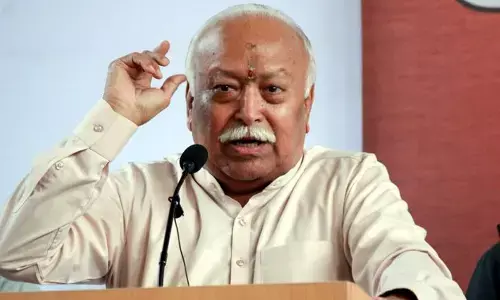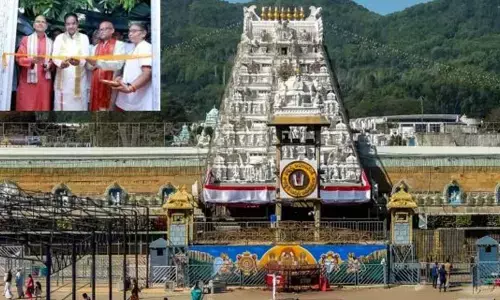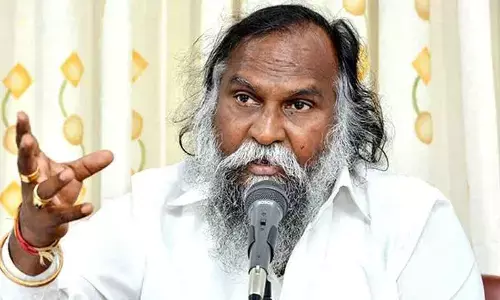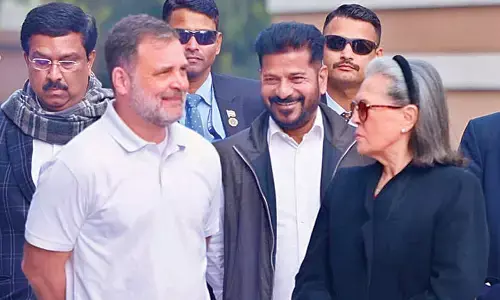Sculpting statues, a dying art

Atop the hills of Jagadgirigutta, a 59-year-old Venkata Narsaiah Chary is still struggling to keep the \"Shilpi\" culture alive in the society. Hailing from an orthodox Vishwakarma Brahmin family, Narsaiah didn\'t want to restrict the craft of temple architecture as a caste occupation.
Jagathgirigutta: Atop the hills of Jagadgirigutta, a 59-year-old Venkata Narsaiah Chary is still struggling to keep the "Shilpi" culture alive in the society. Hailing from an orthodox Vishwakarma Brahmin family, Narsaiah didn't want to restrict the craft of temple architecture as a caste occupation.
Instead, the sculptor trained men of other communities about the craft of chiseling granite structures of deities and today provides livelihood to nearly 10 to 15 families of poor artisans belonging to various districts of Telangana. Being a native of Rayalaseema, Narsaiah started his journey as a sculptor way back in 1974 from Allagadda in Kurnool where he trained rigorously for three years before shifting to Hyderabad.
"Sculpting temple idols was never a profession to me. It was a sacred act of showcasing my devotion to the almighty for whatever he had bestowed me with. So, I wanted to master the craft in every way possible.
In this journey, I was mesmerized by the perfection of Tamil temple sculptures and carvings because of which I became an apprentice of Tirumala Chary. My guru did not just teach me the nuances of the art but was also instrumental in shaping my spiritual beliefs and inculcated values of dedication, team spirit etc making me a better sculptor in a span of 10 years. And it was a year later that I decided to start a workshop of my own as a means to spread the art." shares Narsaiah.
From procuring granite slabs of a considerable thickness from Guntur and designing the features as per the requirements of the client to dividing the labour among his men, Narsaiah makes sure that the idols or the temple carvings are delivered on the promised time with no compromise in its quality.
It is interesting to know that the 59-year-old had been one among the creative brains behind carving structures at the famous Peddamma Temple in Jubilee Hills while it was being renovated and today his craftsmen's creations find their way in shrines not just within the Telugu speaking states but also in Pune.
But despite being praised for chiseling beautiful masterpieces, Narsaiah worries that the art would soon see a near end as traditional artisans are slowly moving away from the craft as it no longer fetches them a sufficient livelihood.
" We don't have any special allocations or grants from the government to preserve our art form. With no bank ready to fund us, we are forced to depend on private money lenders to keep the work going and to pay our craftsmen. Moreover, since the craft is seasonal in nature as no one wants to buy idol during inauspicious months or the Moodalu period of the year, we have no other option but to stay unemployed for almost 5 to 6 months without work or find other means to sustain ourselves and our families.
It is during this period, that our debts keep increasing and we have no one to support. Not even our local leaders are bothered about our sad state. Although the income we earn now is somewhat enough to feed ourselves, the craft is slowly losing its value with people selling readymade idols in the market." reveals Narsaiah.
Confined to a small roof shed and an equally compact storage room, the works of Narsaiah and his craftsmen come to a complete halt when it rains as the waters enter their workspace. Apart from the increasing labour and transportation charges, the craftsmen also face several health hazards due to being continuously exposed to the dust from the granite slabs.
Many times they also get physically hurt by pieces of stone that pierce through their flesh or hit the eye while working on them. " Which trade has no risks? Even sculpturing has but that doesn't mean we will let go of it.
All we ask for is recognition of our craft from the government. Today there are only 14 workshops like this across the twin cities but if the officials do not highlight its importance in the society and allocate a separate functional workspace to promote among youngsters, the art might see its end in the near future.
It is an irony that the state government which is ready to give special provisions for establishing multinational companies is turning a blind eye to the problems of craftsmen like us." sighs the sculptor.
Isn't it unfortunate that those sculpturing the idols of deities lead such harsh lives? It is high time that the state government takes measures to uplift these communities from the miserable lives they are leading!



















